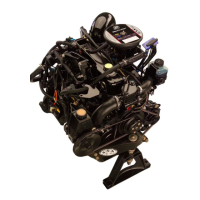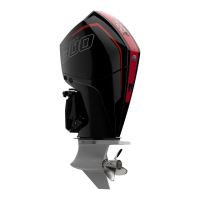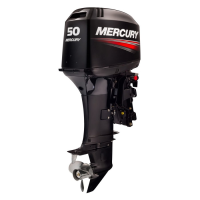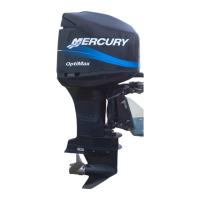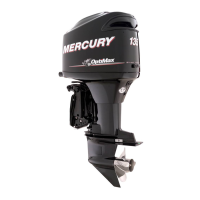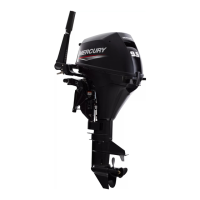90-826148R2 MARCH 1997 IMPORTANT INFORMATION - 1C-3
CAVITATION
Cavitationis causedby water vapor bubbles forming
either from a sharp edge or angle on the gear case
or from an irregularity in the propeller blade itself.
These vapor bubbles flow back and collapse when
striking the surface of the propeller blade resulting in
the erosion of the propeller blade surface. If allowed
to continue, eventual blade failure (breakage) will
occur.
Engine
DETONATION
Detonation in a 2-cycle engine resembles the “ping-
ing” heard in an automobile engine. It can be other-
wise described as a tin-like “rattling” or “plinking”
sound.
Detonation is an explosion of an unburned portion of
thefuel/airchargeafterthespark plug hasfired. Det-
onation creates severe shock waves in the engine,
and these shock waves often find or create a weak-
ness: The dome of a piston, cylinder head/gasket,
piston rings or piston ring lands, piston pin and roller
bearings.
A few of themost commoncauses of detonation ina
marine 2-cycle application are as follows:
· Over-advanced ignition timing.
· Use of low octane gasoline.
· Propeller pitch too high (engine RPM below rec-
ommended maximum range).
· Lean fuel mixture at or near wide-open-throttle.
· Spark plugs (heat range too hot - incorrect reach
- cross-firing).
· Inadequate engine cooling (deteriorated cooling
system).
· Combustion chamber/piston deposits (result in
higher compression ratio).
Detonation usually can be prevented if:
1. The engine is correctly set up.
2. Diligent maintenance is applied to combat the
detonation causes.
51115
Damaged Piston Resulting from Detonation
Following Complete
Submersion
Salt Water Submersion (Special
Instructions)
Due to the corrosive effect of salt water on internal
engine components, complete disassembly is nec-
essary before any attempt is made to start the en-
gine.
Submerged While Running (Special
Instructions)
When an engine is submerged while running, the
possibility of internal engine damage is greatly in-
creased. If, after engine is recovered and with spark
plugs removed, engine fails to turn over freely when
turning flywheel, the possibility of internal damage
(bent connecting rod and/or bent crankshaft) exists.
If this is the case, the powerhead must be disas-
sembled.
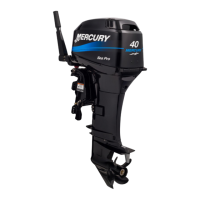
